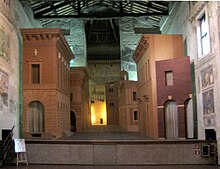Teatro all'Antica
This prestige location had a cost, however, in the form of a cramped and narrow setting that could be successfully converted into a theater only by the considerable ingenuity of one of the Renaissance's most gifted architects.
Such influences are to be expected; Scamozzi had overseen the construction of the Teatro Olimpico following the death of the great Andrea Palladio, who had laid out its original design.
The theatre building is roughly three times as long as it is wide, whereas the space occupied by the Teatro Olimpico is approximately square.
As well, Scamozzi abandoned completely the elaborate and classically inspired scaenae frons that in many ways is the defining feature of the Teatro Olimpico.
As an integral part of the illusion, the floor level rose rapidly to allow the buildings to shrink vertically, and the two sides of the street closed in on each other sharply.



